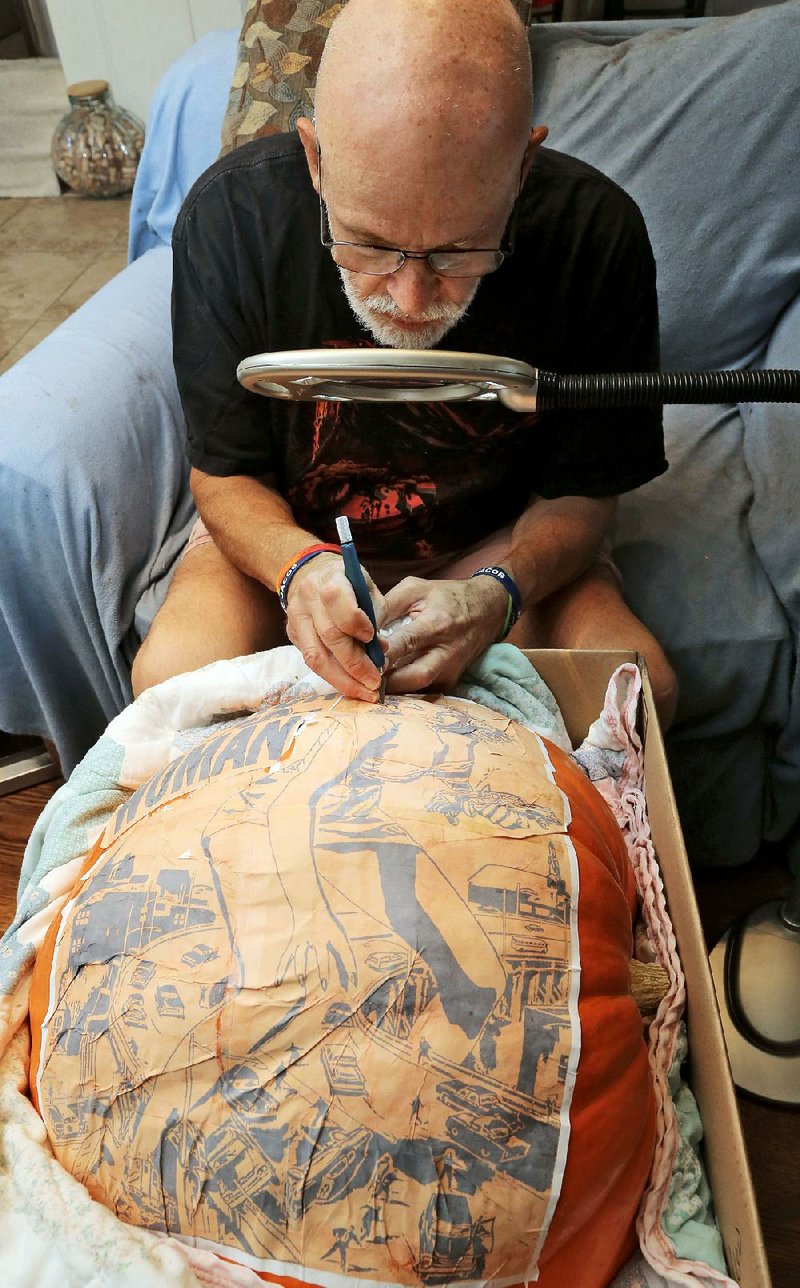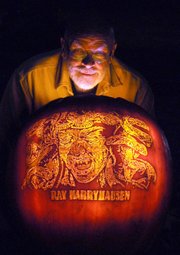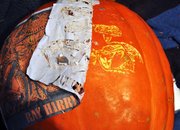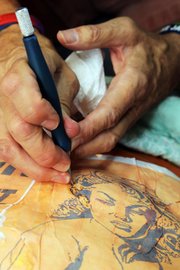When fall breezes arrive and Halloween decorations spring up on front porches, some creative types work in an organic medium wielding knives and scalpels. The pumpkin is their canvas.
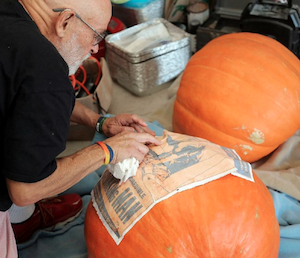
RELATED STORIES
Are they off their gourds?
Skeptics need only view a masterfully carved jack-o'-lantern to see the light.
Johnny Angell of Maumelle, 69, has been creating elaborate jack-o'-lanterns for more than two decades.
"When I was still in San Diego prior to 1992, I found some of the Pumpkin Master patterns and later found websites on the Internet where people were discussing what they were making," says Angell, a retired Alltel computer programmer.
One of his favorite sites is carvingpumpkins.com. "I've learned a lot about carving there," he says.
From there, he began using Photoshop to create his own patterns. He believes his interest in computer graphics has helped his hobby. "I couldn't do this without the Photoshop patterns. Making a better pattern that's clean and clear is key," he says.
First, he prints his pattern out on multiple sheets of paper and pieces them together with tape. He attaches the pattern to the pumpkin with washable school glue. On the pattern, areas where he will shave the skin off the pumpkin are colored orange. Black marks areas to leave intact.
Angell begins tracing the pattern onto the skin of the pumpkin, cutting into it a little bit at a time, removing pieces of the pattern gradually.
Through the years, Angell discovered some mistakes can be corrected.
"Once I cut off a part of the pumpkin I shouldn't have and was surprised to discover that I could Superglue the piece back into this wet pumpkin and it would stay."
FATHER, SON, ZOMBIE
Last Halloween, visual artist Matt McLeod, who recently opened a gallery at Sixth and Main in downtown Little Rock, tried his hand at pumpkin carving with his son Morgan, then 14, at the Mac-O-Lanterns pumpkin carving event in MacArthur Park in downtown Little Rock.
The father and son entered the teen division for large pumpkins weighing 40 pounds and more.
"His idea was to do a zombie one -- he's a huge fan of The Walking Dead -- so we made one and had a lot of fun with it," McLeod says. Their jack-o'-lantern featured seeds and pumpkin innards coming from its mouth and a knife stuck into the side of its head.
Though they didn't win the contest, they had a great time. "We were moderately creative and had a whole lot of fun," McLeod says. "And we'll definitely be making one for our home again this year."
At this year's second Mac-o-Lanterns, beginning at 5:30 p.m. Friday in MacArthur Park, the public will be provided with pumpkins to paint and can watch as invited artists carve jack-o'-lanterns.
About 10 years ago, Angell discovered that by shaving off the flesh to the point where the light shines through in varying degrees, he could create an array of different textures and shading.
Instead of using tools specially created for pumpkin carving, Angell prefers using an X-Acto knife and other small knives he thinks were originally designed for carving balsa wood.
Angell doesn't consider himself to be an artist. That, he says, is because he doesn't create artwork of his own but instead copies horror, science fiction, or monster movie posters from the 1950s or earlier. He hasn't entered his creations into any contests because the artwork he's using for a pattern isn't his own.
Angell has reproduced images from posters for vintage films such as King Kong, Creature From the Black Lagoon, The Phantom of the Opera, The Mummy, The Bride of Frankenstein and Forbidden Planet.
"This year's theme is 'Size Matters,'" Angell says. He is planning to carve images from The Incredible Shrinking Man, The Amazing Colossal Man and The Attack of the 50-Foot Woman.
"Last year, for the first time, I did a humorous one, one of the B. Kliban cats portraying King Kong on the Empire State Building," says Angell, who also once crafted a self-portrait onto a pumpkin.
FEWER AND BIGGER
In about 2006 or 2007, he transitioned from working on five average-size pumpkins a year to three larger ones, about 70-75 inches in circumference. He appreciates having more room for detail.
It takes two men to lift a large pumpkin. He has never weighed them, but he estimates they weigh about 75 pounds. Two weeks before Halloween, he starts carving them, one at a time. Each pumpkin takes about four days to complete.
The larger pumpkins cost $40 to $80 and up, says Angell, who does his pumpkin shopping in early October.
When he's ready to begin his work, he rolls his pumpkin into the living room from the garage on a dolly he borrows from his neighbor Steve Boyle.
Boyle also helps him unload the pumpkins from his vehicle. "He is critical to my pumpkin carving," Angell says.
He lays newspaper on the floor, parks the dolly in front of his couch and begins his work. He starts by carving layers into the exterior flesh of the fruit following the pattern he has chosen.
"All kinds of pumpkin flakes go all over the house," he says.
"Part of my ritual for when I'm carving is that I put on DVDs of some of my favorite monster movies; not to watch them but instead just to listen to the soundtrack from them."
PRESERVE THE FLESH
When he's not working on them, he covers carved areas with a moist towel soaked in a mild solution of bleach and water to help preserve the cut flesh.
"What I could really use is one of those big walk-in refrigerators," Angell says. Lower temperatures would also help. "I'm getting real tired of all these warm Octobers we've been having."
Halloween morning, he'll finally open up each pumpkin and gut it, scraping the insides until light can shine through the carved areas.
"Once you open them up, that's when they really begin to deteriorate at a high rate," Angell says. "And then it's ready to be lit." He uses LED handheld work lights powered by an extension cord.
"When the pumpkin works, it really comes alive and looks like a whole different thing," Angell says.
He displays his creation in his front yard. Friends, neighbors and others come by each year to see his latest works.
"I think my neighbors think I'm nuts," he says, laughing.
He continues to light the jack-o'-lanterns the day after Halloween, but after that it's time to bid them farewell. His final chore is to cut them up and dispose of them in his trash can.
"There's a little bit of regret at that point," he says. "It's kind of bittersweet. But I've taken photographs of them, so I have those."
HomeStyle on 10/24/2015
